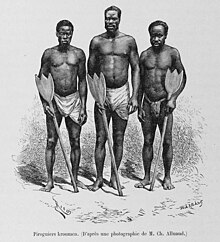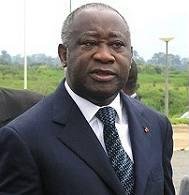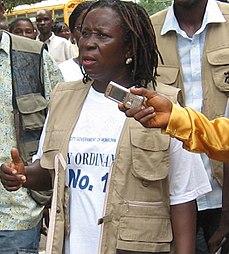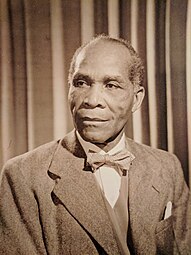Kru people
| Regions with significant populations | |
|---|---|
| 34,000[1] | |
| 209,993[2] | |
| approx. 16,000[3] | |
| Languages | |
| Kru, Bété, Liberian English, Ivorian French, Sierra Leone English, Kriol, French, Bassa, Nouchi, Dida, Guéré, Nyabwa, Krumen language, Ahizi, Godié, Krio | |
| Religion | |
| Christianity, African traditional religions, Sunni Islam | |
| Related ethnic groups | |
| Bassa, Jabo, Krahn, Grebo | |

The Kru, Krao, Kroo, or Krou are a West African ethnic group who are indigenous to western Ivory Coast and eastern Liberia. European and American writers often called Kru men who enlisted as sailors or mariners Krumen. They migrated and settled along various points of the West African coast, notably Freetown, Sierra Leone, but also the Ivorian and Nigerian coasts.[4] The Kru-speaking people are a large ethnic group that is made up of several sub-ethnic groups in Liberia and Ivory Coast. In Liberia, there are 48 sub-sections of Kru tribes, including the Jlao Kru.[5] These tribes include Bété, Bassa, Krumen, Guéré, Grebo, Klao/Krao, Dida, Krahn people and Jabo people.
History
[edit]During the Atlantic slave trade, Kru people were considered more valuable as traders and sailors on slave ships than as slave labor, and Kru oral traditions strongly hold that they were never enslaved.[6] To ensure their status as “freemen,” they initiated the practice of tattooing their foreheads and the bridge of their nose with indigo dye to distinguish them from slave labor.[7][8] Many were called Krumen by Europeans, and hired as free sailors on European ships in both the slave trade and trade in goods. The Kru sailors were famous for their skills in navigating and sailing the Atlantic. Their maritime expertise evolved along the west coast of Africa where they made a living as fishermen and traders. Knowing the in-shore waters of the western coast of Africa, and having nautical experience, they were employed as sailors, navigators and interpreters aboard slave ships, trading ships, and American and British warships used against the slave trade.[6][9]
The Kru history is one marked by a strong sense of ethnicity and resistance to occupation. In 1856 when part of Liberia was still known as the independent Republic of Maryland, the Kru along with the Grebo resisted Maryland settlers' efforts to control their trade. They were also infamous amongst early European slave raiders as being especially resistant to the slave trade.
Origins
[edit]Oral tradition remains the most important key to the origin of the Kru. Traditions recorded in the mid nineteenth century by James Connelly relate that the Kru communities that lived along the shore of what is today southern Liberia and the reputed core settlement of the Kru came down to the coast from the interior "some three generations back — say one hundred to one hundred fifty years..." from an original place he called Claho. Coming down the Poor River they "learned the value of salt" and founded the town of Bassa. They subsequently moved again to Little Kroo, and then were subsequently joined by more Kru-speaking communities from the interior.[10] These events likely occurred in the 18th century and are believed to be connected to more intensive European interest in trade in the region at this time.[11] The original settlers from the interior eventually established five towns: Little Kroo, Setra Kroo, Kroo-Bar, Nana Kroo and King Will's Town, that came to be regarded as their home district, though soon other offshoots developed along the coast, and particularly in Freetown, Sierra Leone.[12][13] However, these accounts are often biased because of Europeans' lack of understanding the Kru language; for example, the term "Bar" or "bah" would signify a river mouth, rather than the proper name of a town. The towns listed by European and American authors are often Anglicized; Settra Kru's name in the Klao language is actually Welteh. Many debates over Kru origins and settlement persist today, including the oft-cited origin of the Kru name as originating in a ship's "crew." In actuality, the title "Kru" comes from an Anglicized version of the Kru term for their own tribe: Klao.
Seafaring
[edit]From the late eighteenth century onward, Kru men (from whence the term Krumen derives) began working on European ships. By the 1790s the inhabitants of their original region were being hired as free sailors on European ships.[14] As the so-called "legitimate trade" replaced the slave trade in the nineteenth century and as trade along the West Africa coast increased, many Kru sailors signed on to the new vessels as seamen. In the process there developed Kru communities around all the major trading factories of the coast, from Sierra Leone around to the mouth of the Congo River.[15]
A number of Kroomen (between 20 and 30) are buried in the Seaforth Old Burial Ground in Simon's Town, South Africa, where their graves can still be seen, and Kroomen is the name used to describe them on their gravestones.[16] They were active in the Royal Navy from 1820 to as late as 1924; for example, HMS Thistle landed a camp party with 12 Krumen in Elephant Bay in June of that year. Many Kroomen joined the dockyard staff, while others remained on board RN ships as seamen. They were given Westernized or diminutive names by the men on the ships, Tom Ropeman, Bottle of Beer, and Will Cockroach amongst them.[17] They were clearly commonly employed, and the names bestowed were not original, since the cemetery contains for example the remains of Tom Smith Number 1, to distinguish him from another Tom Smith.
Kru sailors were organized as small companies under a headman. They would paddle in small canoes as far as a dozen miles out to see to meet ships as they arrived and negotiated their employment on the spot. Headmen often carried credentials from previous stints of employment in boxes or other containers, and negotiations were conducted rapidly. During the earlier part of the nineteenth century foreign observers often gave the Kru high praise for their honesty, courage, efficiency and willingness to do hard work. Later observers, however, had more disparaging comments to make, though either way, few ships plied African waters without many Kru sailors on board.[18]
Although initially Kru men were interested only in sailor's work, in time some took up land based employment doing all sorts of work in the many trading factories that grew up all along the African coast from Sierra Leone to the mouth of the Congo River. They were also recruited as soldiers and common laborers, some traveling as far as India and the Malayan peninsula to the east. Krumen workers served French employers in the French attempt to dig the Panama Canal, others were employed in Jamaica.[19] Others formed communities in the UK, like the Kru town in Liverpool.[20]
Culture
[edit]In the late nineteenth century, reports described the Kru as divided into small commonwealths, each with a hereditary chief whose duty was simply to represent the people in their dealings with strangers. This remains the case in many enclaves today. Power was vested in the elders, who wore as insignia iron rings on their legs. Their president, who held religious authority as well, guarded the national symbols, and his house was sanctuary for offenders until their guilt is proved. Personal property was held in common by each family. Land also was communal, but the rights of the actual cultivator ceased when he failed to farm it.[21]
Religion
[edit]The first descriptions of core group of Kru religion were done by missionaries, notably James Connolley,[22] But these accounts can also be augmented by more detailed accounts of the Grebo of nearby Cape Palmas who were linguistically and culturally related. The central elements of the spiritual universe of this region included a figure identified by missionaries as a high, creator God, named Nyesoa, spirits or deities associated with territories, familial spiritual guardians or the souls of the departed who remained near by and could influence events.
In some areas of Liberia, these spiritual entities were contacted through a class of people called deya, who underwent long and specialized training and apprenticeship to take up their office. They addressed problems both medical and spiritual using pharmaceutical and spiritual remedies.[23][24]
Kru language
[edit]Wilhelm Bleek classified the Kru language with the Mandingo family, and in this he was followed by R. G. Latham; S. W. Koelle, who published a Kru grammar (1854), disagreed.[21] Now Kru is considered a primary branch of the Niger-Congo family.
Distribution
[edit]The Kru are one of the many ethnic groups in Liberia, comprising 7% of the population. Theirs is also one of the main languages spoken. The Kru are one of the main indigenous group players in Liberia's socio-political activities.
Notable people
[edit]Notable ethnic Krus include the 25th President of Liberia George Weah, who is of mixed Kru, Gbee, Mano, and Bassa heritage, as well as his predecessor, President Ellen Johnson Sirleaf, who is of mixed Kru, Gola, and German ancestry. Dr. George Toe Washington, former Armed Forces Chief of Staff of Liberia and ambassador to the United States, Canada, and Mexic, is of Kru and Grebo ancestry. Football star William Jebor is exclusively of Kru background.[25][26][27] Mary Broh, the former mayor of Monrovia, is of mixed Kru and Bassa ancestry. And Didwho Twe, a judge and politician who ran for President of Liberia in 1951, was of Kru heritage.[28]
-
George Weah (1966–present), 25th President of Liberia
-
Ellen Johnson Sirleaf (1938–present), 24th President of Liberia
-
Koudou Gbagbo Laurent, former Ivorian President (2000–2011)
-
Mary Broh (1951–present), former Mayor of Monrovia, Liberia
-
Didwho Welleh Twe (1879–1961), candidate for the Liberian Presidency in 1951
See also
[edit]References
[edit]- ^ https://joshuaproject.net/people_groups/11251/GH
- ^ "Liberia - World Directory of Minorities & Indigenous Peoples". Minority Rights Group. June 19, 2015.
- ^ [1]
- ^ Gunn, Jeffrey (2021). Outsourcing African Labor: Kru Migratory Workers in Global Ports, Estates and Battlefields until the End of the 19th Century (1 ed.). Germany: De Gruyter. ISBN 978-3110680225.
- ^ Tonkin, Elizabeth (1978). "Sasstown's Transformation: The Jlao Kru, 1888-1918". Liberian Studies Journal. 8 (1): 1–34.
- ^ a b Gunn, Jeffrey (2021). Outsourcing African Labor: Kru Migratory Workers in Global Ports, Estates and Battlefields until the End of the 19th Century (1 ed.). Germany: De Gruyter. p. 53. ISBN 978-3110680225.
- ^ McAllister, Agnes (1896). A Lone Woman in Africa: Six Years on the Kroo Coast. New York. pp. 143–5.
{{cite book}}: CS1 maint: location missing publisher (link) - ^ Crutcher, Megan (2022). "Jack Tar's ink: a comparative analysis of Euro-American and West African sailors' tattoos during the eighteenth to twentieth centuries". Maritime Studies. 22 (1). doi:10.1007/s40152-022-00291-0.
- ^ Crutcher, Megan (2023). "'For King and Empire': The Changing Political, Economic, and Cultural Identities of Kru Mariners in Atlantic Africa, 1460–1945". Journal of African History. 64 (3): 8. doi:10.1017/S0021853723000567. S2CID 261478459.
- ^ James Connelly,"Report of the Kroo People" Annual Report of the American Colonization Society 39 (1856) p. 38.
- ^ George Brooks, The Kru Mariner in the Nineteenth Century: An Historical Compendium, (Newark, DE: Liberian Studies Association of America, 1972), pp. 76-77.
- ^ Ludlam, "An Account of a Tribe of People called Croomen..." in Report of the Directors of the African Institution 6 (1812) p. 44.
- ^ Connelly, "Report", p. 38.
- ^ The earliest reference is Thomas Winterbottom, An Account of the Native Peoples in the Vicinity of Sierra Leone (London, 1803), p. 8.
- ^ Brooks, Kru Mariner. pp. 44-59.
- ^ The West African Kroomen and their link to Simon's Town by Joline Young, South African History Online
- ^ Gunn, Jeffrey (2021). Outsourcing African Labor: Kru Migratory Workers in Global Ports, Estates and Battlefields until the End of the 19th Century (1 ed.). Germany: De Gruyter. ISBN 978-3110680225.
- ^ Brooks, Kru Mariner, pp. 1-59.
- ^ Christine Behrens,Le Croumen de la côte occidental de l'Afrique (Talence: Ministère de la Education Nationale, 1974) pp.65-82.
- ^ Diane Frost, Work and Community Among West African Migrant Workers Since the Nineteenth Century, (Liverpool, 1999)
- ^ a b One or more of the preceding sentences incorporates text from a publication now in the public domain: Chisholm, Hugh, ed. (1911). "Krumen". Encyclopædia Britannica. Vol. 15 (11th ed.). Cambridge University Press. p. 933.
- ^ Connolley, "Report" p. 39 [full citation needed]
- ^ Anna M. Scott, Glimpses of Life in Africa (New York: American Tract Society, n. d. [1857]). This short pamphlet, clearly clouded by a Christian and missionary perspective nevertheless lays out quite clearly the cosmology of mid nineteenth century Grebo.
- ^ J. Payne "Rr Rev Bishop Payne's Report on the Grebo Tribe, of Cape Palmas,"Annual Report of the American Colonization Society 39 (1856) pp. 36-37.
- ^ "BBC News, Profile: George Weah". BBC News. 2005-11-11. Retrieved 2012-12-23.
- ^ Kramer, Reed (2008-05-14). "Reed Kramer, "Liberia: Showered With Enthusiasm, Liberia's President-Elect Receives High-Level Reception in Washington", AllAfrica.com, 11 December 2005". Allafrica.com. Retrieved 2012-12-23.
- ^ "Ellen Johnson-Sirleaf". Britannica.com. Retrieved 2012-12-23.
- ^ "The Man Called D. Twe". The Perspective. Archived from the original on 1 February 2019. Retrieved 1 February 2019.
Further reading
[edit]- Baldwin, Lindley, Samuel Morris: Men of Faith Series, Bethany House Publishers, 1942;
- Behrens, Christine Les Kroumen de la Côte Occidentale d'Afrique, Bordeaux: Centre d'Etudes de Géographie Tropicale, 1974;
- Brooks, George, The Kru Mariner in the Nineteenth Century: A Historical Compendium, Newark,Del., 1972 (Liberian Studies Monograph Series no.1);
- Crutcher, Megan, "‘For King and Empire’: The Changing Political, Economic, and Cultural Identities of Kru Mariners in Atlantic Africa, 1460–1945", Journal of African History (2023) 1-12;
- Davis, Ronald, Ethnohistorical Studies on the Kru Coast, Newark, Del., 1976 (Liberian Studies Monograph Series no.5);
- Fraenkel, Merran, Tribe and Class in Monrovia, New York-London: OUP, 1964;
- Gunn, Jeffrey, Outsourcing African Labor: Kru Migratory Workers in Global Ports, Estates and Battlefields until the End of the 19th Century, Germany: De Gruyter, 2021 (Africa in Global History Series);
- Mekeel, Scudder, "Social Administration of the Kru: A Preliminary Survey", Africa 10 (1937) 75–96; 11 (460-68);
- Massing, Andreas W., The Economic Anthropology of the Kru, Wiesbaden: Steiner, 1980 (Studien zur Kulturkunde 55);
- Massing, Andreas W., Kru, in The Oxford Encyclopedia of Maritime History, vol.2, 306–309, New York, 2007;
- Schwartz, Alfred, Peuplement Autochthone et Immigration dans le Sud-Ouest Ivoirien, Abidjan: ORSTOM, 1973;
- Tauxier, Louis, Les Kroomen de la Forêt de Côte d'Ivoire, Paris: Larose, 1935;
- Zetterström, Kjell, Ethnographic Survey of Southeastern Liberia: Preliminary Report on the Kru, Robertsport: Centre of African Culture, 1969





